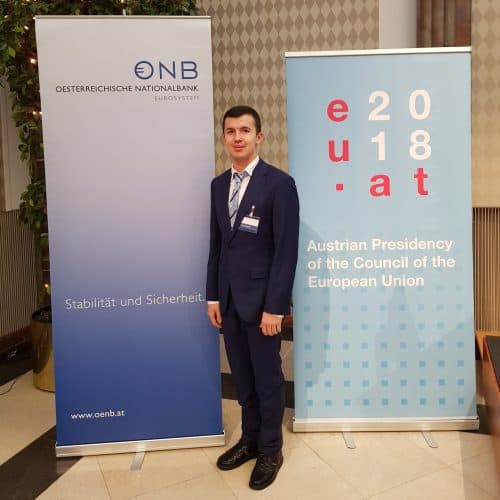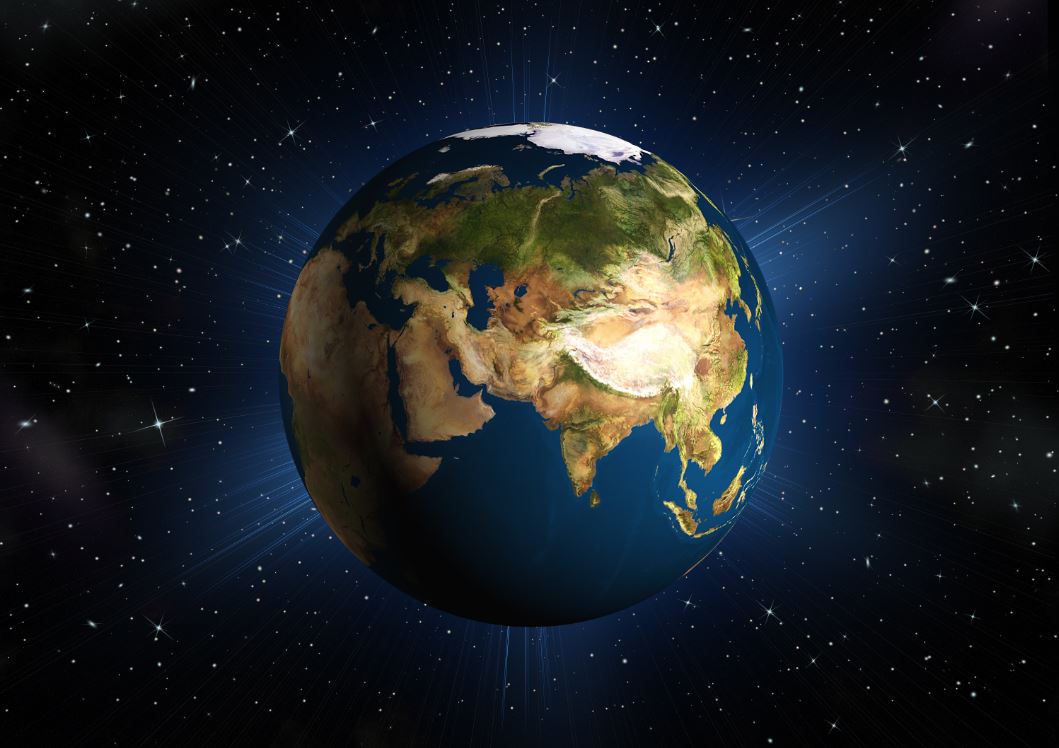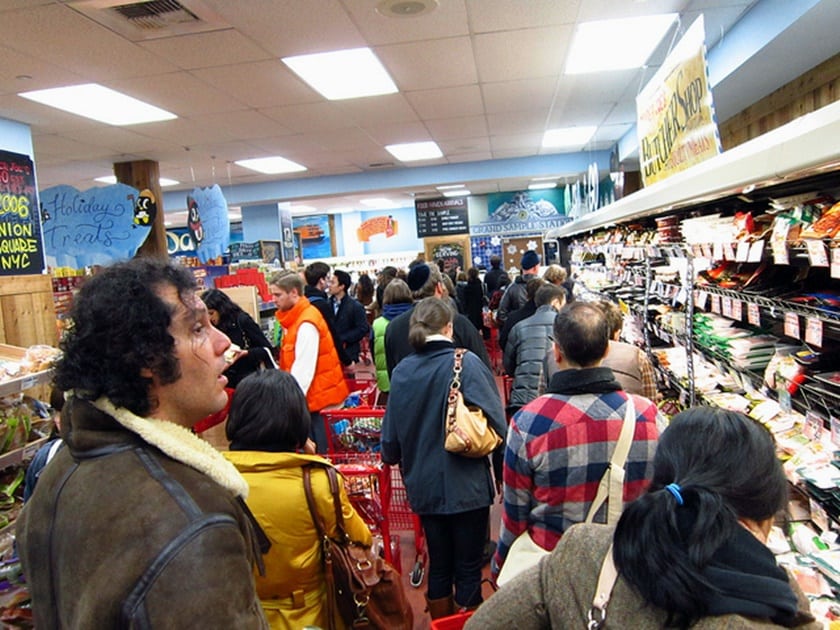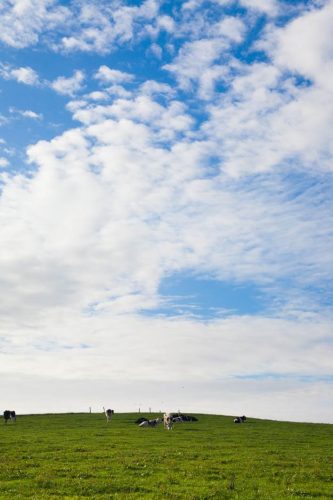Jan 16, 2019 | Economics, Eurasia, Russia, Systems Analysis
By Dmitry Erokhin, MSc student at Vienna University of Economics and Business (Wirtschaftsuniversität Wien) and IIASA Youth Forum participant

Dmitry Erokhin at “Connecting Europe and Asia”
On 14 December 2018, the Austrian Central Bank and the Reinventing Bretton Woods Committee co-organized a high-level conference on “Connecting Europe and Asia,” convening high-level policy makers, top business executives and renowned researchers. Taking place toward the end of the Austrian Presidency in the Council of the European Union, the goal of the event was to discuss ways to improve cooperation between Europe and Asia.
As a true Eurasianist and a member of the European Society for Eurasian Cooperation I was really interested in attending the conference.
It was opened by the governor of the Austrian Central Bank, Ewald Nowotny, who said that cooperation between Asia and Europe is vital, especially with China’s growing economic and political influence. Nowotny expressed regret that some countries see this as a challenge rather than an opportunity. Europe, however, remains the best place to be because of its economic strength.
Marc Uzan, the executive director of the Reinventing Bretton Woods Committee, noted that we live in a new age of connectivity. The economic ties between the EU and Asia are quite strong but there is still space for stronger connectivity in the form of physical and non-physical infrastructure, market integration, and maintaining stability in Central Asia. Uzan highlighted the role of the European Investment Bank in various connecting projects.
During the panel session on “Integration in Europe: European Union and Eurasia”, Elena Rovenskaya, the program director for Advanced Systems Analysis at IIASA, presented the institute as a neutral platform for depoliticized dialogue. IIASA has been running a project on the “Challenges and Opportunities of Economic Integration within a Wider European and Eurasian Space” since 2014, analyzing transport corridors, foreign direct investment, and convergence of technical product standards between EU and the Eurasian Economic Union.
This report was especially exciting for me because I had a great opportunity of participating in the International Youth Forum “Future of Eurasian and European Integration: Foresight-2040”, hosted by IIASA in December 2017, and found it interesting to see how research into Eurasian integration at IIASA has advanced since then. The concept of dividing the integration in two subgroups (bottom-up and top-down) suggested by Rovenskaya also seemed new to me.
‘Bottom-up’ integration requires coordination between participating countries and involves development of transport and infrastructure – known as the Belt and Road Initiative – including development of the Kosice-Vienna broad gauge railway extension, and the Arctic railway in Finland. The top-down scenario would be based on cooperation between regional organizations and programs such as the EU, the EAEU and the Eastern Partnership. The challenge lies in harmonizing different integration processes.
I find it unfortunate that despite the positive impact of theoretical EU-EAEU economic integration and cooperation showed by IIASA’s research, the economic relations between the EU and the EAEU are currently defined by foreign policies and not by economic reasoning.
In his address, William Tompson, the head of Eurasia Department at the Global Relations Secretariat of the OECD, highlighted that the benefits of enhanced connectivity were not automatic and that complex packages, going beyond trade and infrastructure, would be needed. I consider that Tompson raised an important point that we should not exaggerate the benefits – landlocked locations and distance to global markets can be mitigated but not eliminated. Coordination among countries to remove infrastructure and non-infrastructure bottlenecks will necessary.
Tompson’s empirics convinced me that there is a call for change. Kazakhstan pays US$250/t of freight to reach the countries with 20% of the global GDP, compared to just US$50 for Germany and the US. This is due to factors like distance, speed, and border crossings.
I was impressed by Tompson’s international freight model. It shows that logistics performance is generally poor, and competition could be enhanced. The link between policy objectives and investment choices is often unclear. Tompson also criticized the ministries of transport, which he called “ministries of road-building”, for not knowing that transport was far more than that.
The head of unit in the European Commission, Petros Sourmelis, presented the EU’s perspective. According to him, the EU is open to deeper cooperation and trade relationships with its Eastern partners, however, there are many barriers, including the EAEU’s incomplete internal market.
I consider the proposal made by Sourmelis that “one needs to start somewhere” and his hope for more engagement quite promising, but engagement at the political level is some way off. However, the EU has seen constructive steps from Russia and is open to talks to build trust.
Member of the Board of the Eurasian Economic Commission Tatyana Valovaya closed the high-level panel session. I think it was a good lead-up to start with a historical analogy of the ancient Silk Road. According to her, the global trade geography in the 21st century is shifting once again to Asia and China was likely to become a leading power within the next 20 years. I was encouraged by the idea that regional economic unions will likely lead to better global governance and building interregional partnerships between Europe, Asia and Eurasia will be vital to achieve it.
Valovaya reminded delegates that in 2003 a lot of political and technical work had been achieved towards EU-Russia cooperation, which had then been stopped for political reasons. In 2015, the EAEU began wider cooperation with China as part of the Belt and Road Initiative, and in May 2018 a non-preferential agreement was signed to harmonize technical standards and custom regulations, to decrease non-tariff barriers as much as possible and to support cooperation projects in the digital economy.
I share the view of Valovaya that the EAEU should not only consider China as a key partner. Valovaya gave the US as a good example, which has multiple economic partnership agreements. She admitted that the EAEU had some “growth pains” but stressed it is normal for such a project and efforts are focused on solving the problems.
As for me, I believe it is necessary to understand the fundamental differences for the further connectivity. Valovaya emphasized that the EAEU was not aiming to introduce a common currency or to create a political union like the EU. EU-EAEU cooperation will strengthen both unions. More technical cooperation will be needed. And, of course, the leaders of the EU should be participating in the dialogue to better understand the EAEU and its work towards more connectivity in Eurasia.
Note: This article gives the views of the author, and not the position of the Nexus blog, nor of the International Institute for Applied Systems Analysis.
Sep 21, 2017 | Eurasia
By Evgeny Vinokurov, Director of the Centre for Integration Studies at the Eurasian Development Bank, member of the IIASA-led project, Challenges and Opportunities of Economic Integration within a Wider European and Eurasian Space
An Italian nursery riddle goes: “Why does the heron stand on one leg? Because if it takes away the second leg, it will fall down!” An ornithologist will tell you that herons have incredibly strong legs. The EAEU, consisting of Armenia, Belarus, Kazakhstan, Kyrgyzstan, and Russia is not a heron – it does need to stand firmly on two legs. In this case, one leg is the European Union, and the other leg is the People’s Republic of China. An economist will tell you that the strength of “economic legs” underpinning the countries which make up the Eurasian Economic Union (EAEU) can be described, at best, as fair to middling: the heavy reliance on oil and gas is not particularly wholesome. That is why Russia and its EAEU partners need to establish close economic ties with both the EU and China.

© Galushko Sergey | Shutterstock
Both partners are critically important for the EAEU. The EU remains its largest trade partner: in 2016 it accounted for 50% of total exports from, and 41% of total imports to the Eurasian Union. EAEU member states are interested in expanding the inflow of European investment capital, transfer of EU technologies, and stable EU demand for energy. The EAEU, in turn, is the third largest EU trade partner (after the US and China); accordingly, the EU may be interested in liberalization of trade with the EAEU (establishment of a free trade agreement), reduction of non-tariff barriers in EAEU member states (with a view to increase EU exports), and stability of EAEU power supplies.
At the same time, the EAEU’s “turn to the East” is slowly gaining momentum: Asia-Pacific Economic Cooperation (APEC) countries,first and foremost, China and Association of Southeast Asian Nations (ASEAN) countries, are beginning to overtake the EU. By the end of 2016, the Eurasian Union had imported 1.5% more goods from APEC countries (42.3% of total imports, mostly from China, Korea, and ASEAN countries) than it did from EU countries. It is also important for EU investors to understand that they are exposed to an ever-increasing risk of losing EAEU markets due to the inflow of capital from the leading Asian economies.
These matters have been subjected to rigorous applied analysis in Challenges and Opportunities of Economic Integration within a Wider European and Eurasian Space, a project initiated by IIASA in 2014. It advanced an independent dialogue platform to facilitate interaction between representatives of supranational bodies, expert and business communities of the two unions. The project is designed to help its European and Eurasian participants find common ground with respect to a possible inter-union trade and economic agreement.
According to project publications , it is advisable to reach a comprehensive agreement covering a much broader range of partnership domains than that associated with a standard free trade area. According to the latest calculations by European and Russian experts, an EU-EAEU free trade agreement would produce a positive impact. However, experts from the Information and Forschung (IFO) institute in Munich point out that EAEU agriculture and automotive industry may suffer heavy losses. This demonstrates that it is necessary to work out a quite structurally complex solution offering asymmetric advantages to the two sides.
Relations with China display completely different patterns. Two following “tracks” are especially important.
The first relates to the ongoing negotiations on a non-preferential agreement on trade and economic cooperation between the EAEU and China, envisaging reciprocal minimization of barriers in customs regulations and the financial sector, and intensification of investment cooperation. Talks have already been underway for one year, and are expected to continue for another year or two.
The second track deals with realization of the One Belt One Road initiative. It involves implementation of large-scale joint infrastructure projects, primarily in transportation. EAEU’s participation in the One Belt One Road initiative is very promising for its member states, especially for Russia and Kazakhstan, which need to remove infrastructural limitations inhibiting railroad carriage of containerized cargoes. The EAEU continues to face the issue of insufficient investment capital allocation to container logistical hubs. Kazakhstan will also need to eliminate bottlenecks in its transportation and logistics infrastructure, primarily by building modern container terminals. These are but several of the numerous problems facing the EAEU.
We are looking at One Belt One Road in the broad Greater Eurasia context. Higher efficiency of Greater Eurasian land transportation corridors could enhance trade and generate numerous industrial opportunities. This is particularly relevant for landlocked countries and regions (all Central Asian countries, Russian Urals and Western Siberia).
Russia and its EAEU partners need to establish close economic cooperation ties with both the European Union and China. The EAEU will have to learn to balance between those two poles, making ample use of economic vistas presented by the tripartite cooperation setup, and “capitalize on contradictions.” If the EAEU manages to reach this overarching goal, its foreign economic policy would be successful.
This article gives the views of the author, and not the position of the Nexus blog, nor of the International Institute for Applied Systems Analysis.
Oct 4, 2016 | Climate Change, Food
By David Leclère, IIASA Ecosystems Services and Management Program
August was the warmest ever recorded globally, as was every single month since October 2015. It will not take long for these records to become the norm, and this will tremendously challenge food provision for everyone on the planet. Each additional Celsius degree in global mean temperature will reduce wheat yield by about 5%. While we struggle to take action for limiting global warming by the end of the century to 2°C above preindustrial levels, business as usual scenarios come closer to +5 °C.
However, we lack good and actionable knowledge on this perfect storm in the making. Despite the heat, world wheat production should hit a new record high in 2016, but EU production is expected to be 10% lower than last year. In France, this drop should be around 25-30% and one has to go back to 1983 to find yields equally low. Explanations indeed now point to weather as a large contributor. But underlying mechanisms were poorly anticipated by forecasts and are poorly addressed in climate change impacts research.

©Paul Townsend via Flickr
Second, many blind spots remain. For example, livestock has a tremendous share in the carbon footprint of agriculture, but also a high nutritional and cultural value. Yet, livestock were not even mentioned once in the summary for policymakers of the last IPCC report dedicated to impacts and adaptation. Heat stress reduces animal production, and increases greenhouse gas emissions per unit of product. In addition, a lower share of animal products in our diet could dramatically reduce pollution and food insecurity. However, we don’t understand well consumers’ preferences in that respect, and how they can be translated in actionable policies.
How can we generate adequate knowledge in time while climate is changing? To be able to forecast yields and prevent dramatic price swings like the 2008 food crisis? To avoid bad surprises due to large missing knowledge, like the livestock question?
In short: it will take far more research to answer these questions—and that means a major increase in funding.
I recently presented two studies by our team at a scientific conference in Germany, which was organized by a European network of agricultural research scientists (MACSUR). One was a literature review on how to estimate the consequences of heat stress on livestock at a global scale. The other one presented scenarios on future food security in Europe, generated in a way that delivers useful knowledge for stakeholders. The MACSUR network was funded as a knowledge hub to foster interactions between research institutes of European countries. In many countries, the funding covered travels and workshops, not new research. Of course, nowadays researchers have to compete for funding to do actual research.
So let’s play the game. The MACSUR network is now aiming at a ‘Future and Emerging Technologies Flagship’, the biggest type of EU funding: 1 billion Euros over 10 years for hundreds of researchers. Recent examples include the Human Brain Project, the Graphene Flagship, and the Quantum Technology Flagship. We are trying to get one on modeling food security under climate change.

© Sacha Drouart
Such a project could leapfrog our ability to deal with climate change, a major societal challenge Europe is confronted with (one of the two requirements for FET Flagship funding). The other requirement gave us a hard time at first sight: generating technological innovation, growth and jobs in Europe -but one just needs the right lens. First, agriculture already sustains about 44 million jobs in the EU and this will increase if we are serious about reducing the carbon content of our economy. Second, data now flows at an unprecedented speed (aka, big data). Think about the amount of data acquired with Pokemon Go, and imagine we would harness such concept for science through crowdsourcing and citizen-based science. With such data, agricultural forecasts would perform much better. Similarly, light drones and connected devices will likely open a new era for farm management. Third, we need models that translate big data into knowledge, and not only for the agricultural sector. Similarly, models can also be powerful tools to confront views and could trigger large social innovation.
To get this funding, we need support from a lot of people. The Graphene project claimed support from than 3500 actors, from citizens to industrial players in Europe. We have until end of November to reach 3500 votes, at least. If you think EU should give food security under climate change the same importance as improving the understanding of the human brain, or developing quantum computers, we need you. This will simply never happen without you! Please help us out with two simple actions:
- Go the proposal, and vote for/comment it (see instructions, please highlight the potential for concrete innovations)!
- Spread the word – share this post with your friends, your family, and your colleagues!
Note: This article gives the views of the author, and not the position of the Nexus blog, nor of the International Institute for Applied Systems Analysis.
Jul 29, 2016 | Air Pollution, Young Scientists
By Anneke Brand, IIASA science communication intern 2016.
Accidents, lane closures, and congestion all affect the flow of road traffic and harmful emissions from vehicles. Live traffic data allow congestion to be detected more accurately and provide a more precise overview of vehicle emissions at different times and places. In his project for the Young Scientists Summer Program (YSSP), Fabian Heidegger investigates how road traffic affects air pollution in cities, using Vienna and surrounding areas as a case study.
Air pollution is a major problem in Europe and globally. Health impacts of air pollution include a range of respiratory and cardiovascular diseases. “10-20% of Europe’s urban population is exposed to excessive levels of nitrogen dioxide (NO2), along with several other air pollutants. NO2 pollution is highest along busy roads. Technical measures have so far often been circumvented, so cities are looking for other measures to reduce the pollution load. Traffic management has therefore gained interest as a way to reduce air pollution,” says Jens Borken-Kleefeld, Heidegger’s study leader at IIASA.
To calculate the amount of air pollution that cars and other vehicles release into the air, researchers use models that apply various sets of data: traffic networks, where and how far people drive, and emission factors of different vehicle categories. Input data for the model may include how many people live in a certain area, how many of them use cars, where they normally drive, and how many grams of pollutants (such as nitric oxide and NO2 gases) their type of cars emit per kilometer.

Inner city Vienna. © Radub85 | Dreamstime.com
Most of these models rely on average daily traffic data. For Heidegger’s YSSP project, which is related to his PhD work at the University of Natural Resources and Life Sciences in Vienna, he is incorporating real-time data, measured every five minutes, into a traffic simulation model developed by Intelligent Transport Systems Vienna Region. A set of detectors in and around the city record the number and speed of vehicles. In addition, location data from the taxi fleet is incorporated into the traffic simulation. Heidegger can therefore immediately identify adverse traffic conditions like stop-and-go traffic, which has a high impact on emissions. This allows for a more accurate calculation and can help design traffic interventions for improving both traffic flow and air quality.
“In the case of a road closure, local emissions will obviously be lower at the specific road but total emissions for the area could be higher than before when drivers use alternative, longer routes or end up in stop-and-go traffic,” says Heidegger.
In order to understand how these diversions and the displacement of pollutants can affect overall emissions, Heidegger will first determine the emissions per street section, and second, what the effects are of diversions from day-to-day traffic patterns. Together with researchers from the Air Quality and Greenhouse Gases Program at IIASA, Heidegger plans to assess the impact of different intervention scenarios, for example an environmental zone in the city, where only modern cars will be allowed to enter. In a second scenario he will look at the effect of people commuting to Vienna, and a third scenario will explore the consequences of expanding pedestrian zones. The researchers hope that this study will better their understanding of the potential of traffic management to reduce air pollution.
More information
Air Pollution Policy Review 2011-2013
GAINS Model
AIR Program
Note: This article gives the views of the author, and not the position of the Nexus blog, nor of the International Institute for Applied Systems Analysis.
Mar 15, 2016 | Alumni, Environment, Young Scientists
By Carlijn Hendriks, Netherlands Organization for Applied Scientific Research (TNO) & IIASA Peccei award winner
Last summer, I participated in IIASA’s Young Scientist Summer Program, working with the Mitigation of Air Pollution and Greenhouse Gases and Ecosystems Services and Management programs. My research focused on what impacts the EU climate and air quality policy could have on ground level ozone around the middle of this century. While clean air policies should help reduce the pollution that can lead to ozone formation, we found that that climate change and energy policies will still increase ozone concentrations and damage by mid-century, unless stricter air pollution measures are implemented.

Ozone forms through reactions of various pollutants and chemicals in the atmosphere – a process that speeds up at higher temperatures. © Damián Bakarcic via Flickr
Ozone at ground level is an air pollutant, causing health and ecosystem problems. It is also an important component of summer smog. Ozone is not emitted into the atmosphere directly, but is produced when volatile organic carbons are oxidized in the presence of nitrogen oxides and light. Nitrogen oxides are released into the atmosphere mainly as a result of combustion processes (like car engines and industry), while non-methane volatile organic carbons (NMVOCs) come in large part from vegetation, especially broad-leaf trees and some fast-growing crops.
Part of the EU energy policy is to stimulate the use of sustainable biomass as an energy source. This could lead to expansion of commercial bioenergy crop production in plantations and an increasing use of forests. While this may help to reduce greenhouse gas emissions, it will also increase NMVOC emissions. At the same time, EU air quality policies aim to reduce emissions of air pollutants such as nitrogen oxides and man-made NMVOC. Because some steps in the ground level ozone formation process are driven by absorption of light and/or proceed faster with higher temperatures, climate change could lead to higher ground level ozone concentrations in the future.
The separate effects of these three trends on ground level ozone have been studied before, but the question remains: what will be the combined impact of a) an increase of bioenergy plantations, b) EU’s air quality policy and c) climate change on health and ecosystem damage from ground level ozone? And which of the trends is the most important? To answer these questions, I used three models to study two energy and air quality scenarios for Europe under current and possible future climate conditions.
Two energy scenarios calculated by the Price-Induced Market Equilibrium System (PRIMES) model form the basis of this work. We used a reference scenario and one in which Europe reaches 80% CO2 emission reduction in 2050. These energy scenarios were used as a basis to calculate air pollutant emissions with IIASA’s Greenhouse Gas and Air Pollution Interactions and Synergies (GAINS) model. Then we put the same scenarios into IIASA’s Global Biosphere Model GLOBIOM to obtain the change in land cover because of increasing bioenergy demand. I combined these datasets in chemistry transport model LOTOS-EUROS (the model of choice at my home institute, TNO) to calculate the impact on ground level ozone concentrations across Europe. To simulate ‘future climate’ we used the year 2003, in which Europe had a very warm summer, with temperatures 2-5 °C higher than normal.

Difference in average ozone concentration (in µg/m3) between the current situation and the 80% CO2 reduction scenario in 2050 under future climate change conditions for the period April-September. Negative numbers mean a decrease in ozone levels.
We found that especially for the CO2-reduction scenario, the increase in bioenergy production could cause a slight increase in ozone damage. However, the impact of reduced emissions because of more stringent air quality policies far outweighs this effect, leading to a net reduction of ozone damage. The third effect, more efficient ozone formation in a warming climate, is so strong that in 2050 ozone damage to human health could be worse than today, especially for northwestern Europe. Stringent air quality policies close to a maximum feasible reduction scenario would be needed to make sure that health and ecosystem damage towards the middle of the century is smaller than it is today.
Note: This article gives the views of the author, and not the position of the Nexus blog, nor of the International Institute for Applied Systems Analysis.









You must be logged in to post a comment.